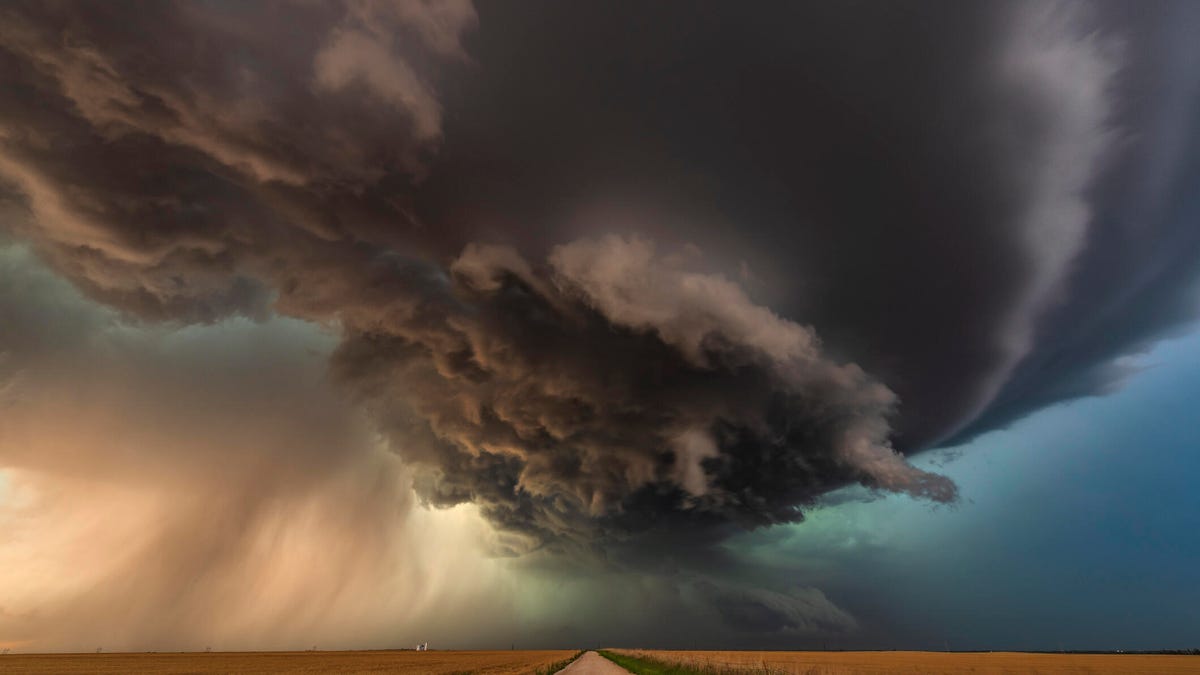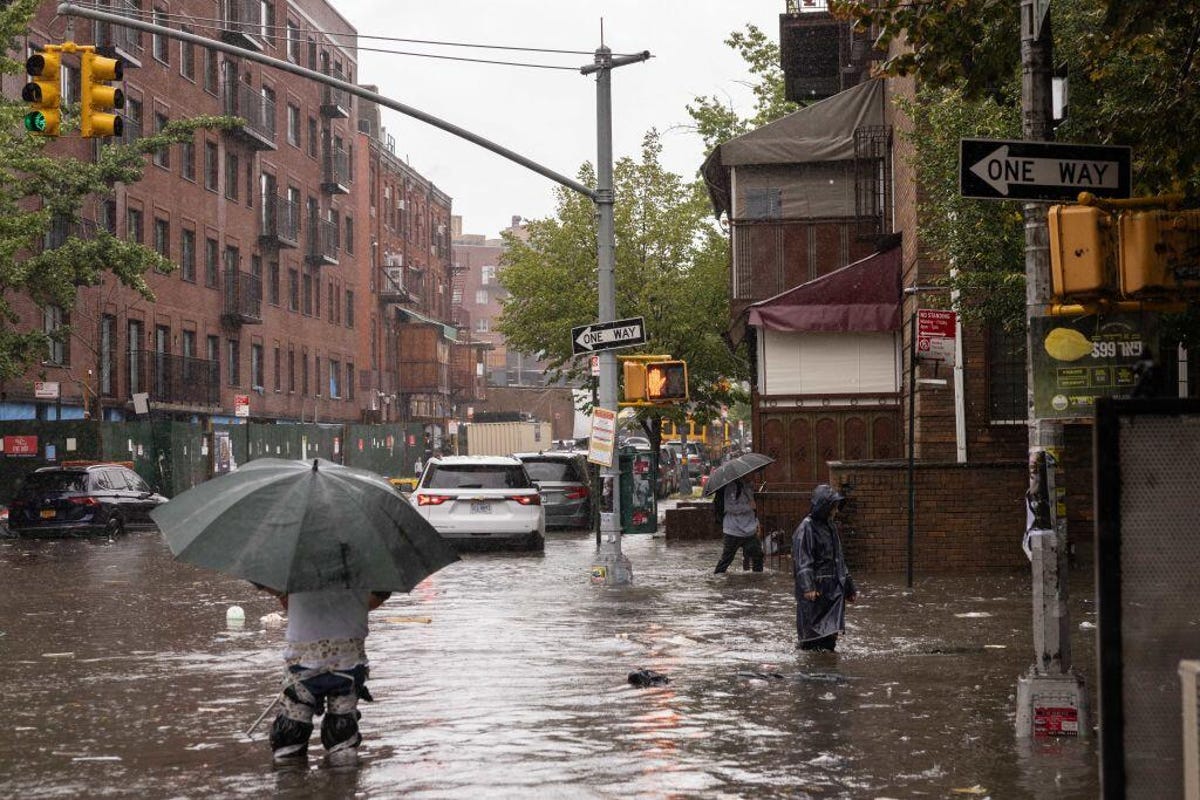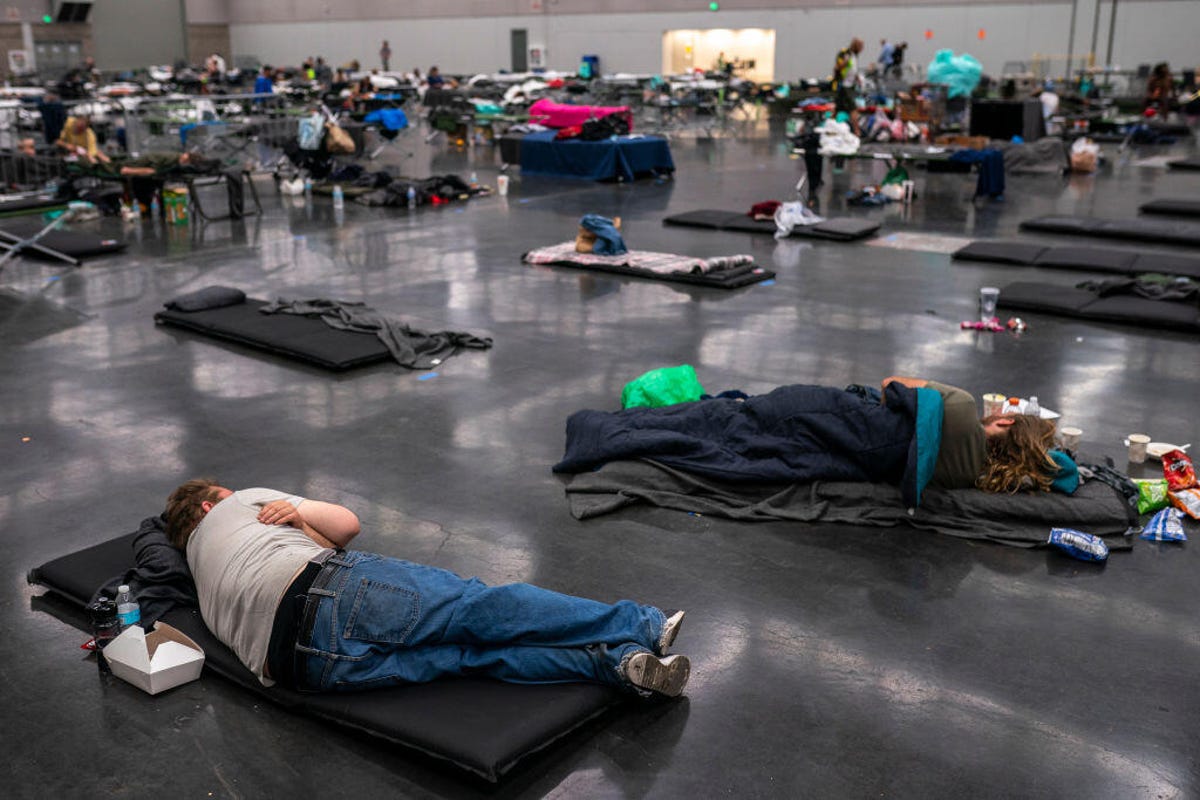Technologies
Wild Weather Ahead: Here’s How 2024 Is Shaping Up After the Hottest Year on Record
The climate crisis is impacting communities around the world. Here’s what to know about dealing with extreme weather in 2024.

We just lived through the hottest year since recordkeeping began more than a century ago, but before too long when we look back at 2023, it might not stand out as the pinnacle of extreme heat.
That’s because it’s unlikely to be the only hottest year that we experience. Our climate is changing, growing warmer due to the emissions from burning fossil fuels, and our weather is changing with it. It’s possible that this year may turn out to be hotter still.
In March, scientists from the EU’s Copernicus Climate Change Service said February 2024 was the hottest February according to records that stretch back to 1940. The news came on the heels of their report in early January that, as expected, 2023 was indeed the hottest year on record. Temperatures closed in on the critical 1.5-degree Celsius rise above preindustrial levels, after which we will see irreversible damage to the planet. These aren’t freak outliers: The extreme heat we’re experiencing is something we’ll need to be prepared to deal with on a much more regular basis, along with storms, floods and drought.
Later in March, the US National Oceanic and Atmospheric Administration issued its spring outlook, predicting that most of the continental US and Alaska will see above-average temperatures from April through June. The risk of flooding, it said, will ease during the three-month period because of «historically low winter snow cover» in large parts of the country.
A key trend highlighted by the US government’s Fifth National Climate Assessment, published in November, was that climate change is provoking extreme weather events across the country that are both more frequent and more severe. It pointed to an increase in heatwaves and wildfires in the West over the past few decades, the increased drought risk in the Southwest over the past century and more extreme rainfall east of the Rockies. Hurricanes have also been intensifying, as those who have found themselves in the path of a storm know all too well.
You’ll need to be prepared. Extreme weather is going to have a widespread impact on industry, society and individuals. Last year in the US there were 25 extreme weather events with losses amounting to over $1 billion that resulted in the deaths of 464 people. People lost their homes, saw personal property damaged or suffered mental and physical health issues.
Three months into 2024, we’re staring down the barrel of another potentially record-setting hot year. If there’s a silver lining, it’s that the US is now better prepared than ever and we know what steps you can take to better deal with these unwelcome events. When it comes to weather, forewarned is forearmed.
The US has been taking active steps. The Biden administration has provided funding to build resilient communities, and a new (as of September 2023) National Climate Resilience Framework, which should provide the US with a whole range of protections. These include conserving water resources, modernizing and strengthening the electric grid against weather and disasters and building infrastructure to protect communities and ecosystems from sea level rise, tidal flooding, hurricanes and storm surges.
At home and in your community, you can take steps, too, including preparing your home for wildfires and flooding and recognizing signs of heat-related health issues. This way, when wild weather comes calling, its impact on our homes, health and livelihoods is minimized.
Forecast 2024
Last year’s heat was no anomaly. It’s part of a long-term trend: The last 10 years have been the 10 warmest on record, according to NASA, with most of the Earth’s warming taking place over the last 40 years. Most forecasters are anticipating yet another year of extreme heat ahead.
«If we look at the forecast for the next three months in the long range, it’s suggesting that the trend that we’re seeing in baseline warming could continue, and so 2024 could rival 2023 for being the hottest year on record, which is very scary,» says Chloe Brimicombe, a heatwave researcher at the University of Graz.
Some of the extreme weather we experienced in the latter half of last year and will continue to experience in the first half of this year is a result of El Niño, a cyclical climate event that sees unusually warm ocean waters that has a knock-on effect of warmer temperatures and increased rainfall across the southern part of the US. For instance, temperatures in Death Valley, California, peaked at 128 degrees Fahrenheit in July, while forecasters predicted warmer temperatures in northern parts of the US stretching into February and a colder, wetter winter for Southern states.

While meteorologists are able to make long-term predictions about El Niño, other climate-related predictions are trickier. «All things told, we’re going to see an increased prevalence of heat events across the globe, but we can’t tell right now exactly where that will be,» says Andy Hoell, a climate scientist at NOAA.
What we do know, he adds, is that the climate crisis can compound events such as extreme heat or extreme rainfall to make them more likely or more severe.
In the past, it wasn’t always easy to draw direct links between extreme weather events and climate change. But huge improvements in attribution science (the ability to specifically identify emissions as the cause for unusually dramatic weather) in recent years have changed the game. The World Weather Attribution program, based at Imperial College London, has now completed nine studies on droughts, heatwaves, wildfires and heavy rainfall in North America. «Every study found that climate change made the event more intense and more likely,» says Ben Clarke, a researcher at WWA.
The speed at which climate scientists are able to identify human-caused climate change as the culprit for extreme weather has also dramatically improved. Last year alone, Climate Central was able to attribute record-breaking spring heat in the western US, and ongoing extreme heat stretching through the summer in Texas and Florida, to climate change as it was happening. «It’s much more impactful as far as our understanding of what climate change really is if we can make that connection in real time,» says Andrew Pershing, vice president of science at Climate Central, a climate science analysis non-profit.
Thanks to attribution science, we can confidently point to a heatwave we’ve experienced and say whether climate change played a role in making it happen. But it also helps us to recognize that extreme weather events we’re experiencing are part of a pattern – one that can’t be broken without tackling the root causes of the climate crisis. «Until the world moves away from fossil fuels and reduces emissions to net zero,» says Clarke, «extreme weather events in North America will continue to become more intense, more dangerous and more deadly.»
Even if you live in a region that hasn’t yet directly been impacted by a climate-linked weather event, you’re not off the hook.
«As the climate continues to warm, most areas will be at an increased risk of some types of climate-linked extreme weather,» says Russell Vose, chief of the Monitoring and Assessment Branch at NOAA’ National Centers for Environmental Information and one of the NCA’s authors. «Perhaps the best example is extreme heat – it can occur anywhere.»
He points to the scorching heat dome that descended on the Pacific Northwest in June and July 2021, which was unprecedented in the historical record. The unpredictable nature of such extreme heat means no regions are marked as safe.
In fact, a region that’s been lucky enough to not yet experience an extreme heat event is more likely to experience one in the future and suffer more greatly due to lack of preparedness, according to a study published by scientists from Bristol University last April.
Scientists are more concerned about the ability of people in areas that don’t usually get intensely hot to cope when their turn comes. «What worries me would be something in the Upper Midwest or the Northeast that just hasn’t had a major heat event for a few years,» says Pershing. «I think we kind of lose a little bit of that muscle memory.»
Weather’s unequal impacts
The weather might not discriminate when it comes to who gets hit, but that doesn’t mean its impacts are experienced equally by all groups across American society.
«Certain groups are simply more vulnerable to extreme events due to geographic, socioeconomic or demographic factors,» says Vose. He points to the extreme rainfall brought by Hurricane Harvey in 2017, which led to a large number of homes being flooded in Harris County, Texas, with a disproportionate impact on low-income Hispanic neighborhoods.
When a heatwave hits, it will feel hotter in high-density urban environments that are more likely to be occupied by people of color or people living in poverty than in more spread-out neighborhoods or rural areas. Then some are homeless and can’t access health care. They have little ability to protect themselves, no matter how much warning they get about an incoming heatwave. This makes these groups much more vulnerable to the health risks of extreme heat.
Heat researchers are extremely concerned about people who live in housing not resistant to warm temperatures, says Brimicombe, who points out that those who rent are especially at risk. «If you’re a tenant, you have less ability to adapt your house to extreme heat than if you’re a homeowner,» she says. «And that also means young families, because babies are vulnerable to extreme heat.»
Not only are economically disadvantaged communities in the US more susceptible to feeling the worst impacts of extreme weather, but they have also done the least to contribute towards the climate crisis in the first place. A study published last August revealed that the wealthiest households in the US are historically responsible for 40% of the country’s climate emissions.
Meanwhile, these same households have more tools at their disposal to protect themselves from the impact of climate-related weather events. In 2019, The New York Times reported that wealthy California residents were banding together to hire private firefighters to protect them from the impacts of wildfires.
The Biden administration is well aware that marginalized and minority groups are hardest hit by climate change, including extreme weather. At the beginning of his term, the president set up the White House Environmental Justice Advisory Council, made up of leading experts from the US climate justice community.
Last September the group published its policy recommendations urging the government to ensure climate disasters do not further or exacerbate harm to vulnerable populations and communities.

«Disaster relief should never be the cause of deepening inequality in any neighborhood, region, or Tribal community,» the council wrote in its recommendations. «When disaster hits, the goal of government should be that the people hit the hardest should emerge stronger and more secure than before, not the opposite.»
It recommended a number of measures that would help protect people in case of extreme weather including the creation of a low-cost national flood insurance and the establishment of a «Just Relocation Fund» that would provide communities hit by climate impacts with a relocation process based on a dignity framework with respect for their human rights.
The White House has yet to respond to the recommendations, but if it does act on them this would hopefully prevent a repeat of the aftermath of Hurricane Katrina in 2005, in which Black communities were allocated less money to rebuild their housing, resulting in a lawsuit against the federal government.
Through the Bipartisan Infrastructure Law and other initiatives, the Biden administration is investing heavily in adaptation, mitigation and resilience measures designed to protect all Americans from the impacts of climate-linked extreme weather. As with all funding, people may have to wait some time to feel the full impact of that funding. In the meantime, there are a number of steps you can take to keep yourself safe in the months ahead.
How to weather the weather, whatever the weather
Summer’s not so far off, meaning sizzling days are on the horizon.
Intense heat poses some scary risks to our health, including heat cramps, heat exhaustion and heat stroke, which can be life-threatening. It’s important to familiarize yourself with the signs so that you’ll recognize them in yourself and others, and can therefore seek medical attention if necessary.
Remember that heat is more likely to adversely affect older people, children and babies, and those with preexisting health conditions. There may be cooling centers or other well-air-conditioned places in your community where you can take refuge – if you do, consider taking elderly or vulnerable neighbors with you. «Look out for friends and families,» said Brimicombe. «Don’t be complacent.»
The British writer and fellwalker Alfred Wainwright is widely credited as coining the phrase, «there’s no such thing as bad weather, only unsuitable clothing.» Wainwright, who died in 1991, didn’t live through the kind of consistently bad weather we’re experiencing in this era of extreme heat, but that doesn’t mean we have nothing to learn from him. In the midst of a heatwave, it’s best to wear loose-fitting clothes in light colors, rather than black, which absorbs the heat.
Make sure you stay hydrated and try to spend as little time as possible outside in the sun. Try to block sunlight from warming your house, and consider buying reflectors to place in your windows that can help keep the heat out. At nighttime, take note of when it might be cooler outside than in, and use this to your advantage by opening doors and windows to let the internal temperature of your house regulate. Fans can be effective, but at very high temperatures they’re likely to just start pushing the hot air around – in which case you should, sparingly and without putting too much pressure on the grid, resort to air conditioning, or moving to your local cooling center.

Remember that global warming is worldwide, so the same heat warnings apply even if you plan to travel to other parts of the world over the summer. The heat waves that hit the US in the summer of 2023 also impacted areas of Europe, including popular vacation spots in the Mediterranean. Countries including Greece, Spain and Italy were all affected by wildfires that resulted in the evacuation of locals and tourists alike from some areas and islands.
The surge in Europe-bound American tourists that occurred in 2023 is expected to continue this year, but if you’re planning to be among them it’s important not to travel without comprehensive insurance. Likewise, if you’re traveling in the peak months of July and August, be prepared to adjust your itinerary in case of extreme heat to ensure you’re not putting your health at risk. This may mean spending more time indoors than you’d planned for the sake of your health.
For other types of extreme weather that may hit your property such as wildfires, storms or floods, it may be useful to have an evacuation plan. You should prepare an emergency evacuation bag, also known as a go bag or a bug-out bag. Don’t forget to plan for your pets. The National Fire Protection Association has a handy guide on how to prepare your home for wildfires.
One of the easiest but most important things you can do is keep an eye on long- and short-term weather forecasts. The silver lining for people in the US, says Pershing, is that the country has great weather forecasting capabilities and the channels to communicate incoming events to people so you can prepare. «The gaps are really whether you take it seriously yourself,» he says.
So for anyone who does take it seriously, be sure to read our tips on how to prepare yourself and your home for wildfires, hurricanes, floods and storms.
Here are some additional resources:
- Natural Disaster Guide: How to Prep for Wildfires, Hurricanes, Storms and More
- Flood Insurance: What It Costs and What It Covers
- Pet Disaster Prep: Take These Steps to Keep Your Pets Safe
- Emergency Prep: 3 Tips to Recover Important Documents
- 16 Emergency Apps for Wildfires, Earthquakes and Other Disasters
- Wildfire Season Is Here: Prepare Your Emergency Evacuation Bag Now
- Climate Change Is Intensifying Severe Weather. Take These 4 Steps to Fortify Your Home
For even more details on natural disasters and how to prepare beforehand or respond after an event takes place, check out https://www.ready.gov/.
Correction, March 15: This story originally misstated the name of the National Fire Protection Association.
Technologies
Razer’s Wolverine V3 Pro 8K Controller Won’t Replace My Mouse and Keyboard, but Here’s Where It Shines
I applaud the absurdly high polling rate, six extra remappable buttons and TMR sticks, but let me tell you why I’m sticking with my keyboard and mouse for most games I play.

The Razer Wolverine V3 Pro 8K PC controller was not built for me, but admittedly, this has more to do with me as a gamer than the controller itself. I grew up playing the PlayStation 3 and PS4 consoles, cutting my teeth on slim, compact DualSense controllers. Over the past five years, I’ve gamed exclusively on my PC and have grown accustomed to the increased precision of a mouse and keyboard.
The Razer Wolverine V3 Pro 8K PC controller is the antithesis of a DualSense controller. It’s a chunky piece of hardware that might feel natural if you were raised on an Xbox and its bulky controllers, but it took me multiple gaming sessions to get acclimated to the sheer size of the Wolverine V3 and how it fit into my hands, especially since I don’t use a claw grip.
Size aside, this is a PC controller with every bell and whistle you can think of — and its price of $200 reflects that. The 8,000Hz polling rate ensures buttery smooth inputs with no lag, and tunnel magnetoresistance joysticks make every in-game movement feel fluid and calculated. Six extra remappable buttons help you up your game — they’re super handy for hero shooters like Marvel Rivals and hectic games like Battlefield 6. This is a premium product for gamers who are hoarding some serious hardware.
Its price is in line with other premium controllers. One of CNET’s best Xbox controllers is the Wolverine V3 Pro for Xbox, which also costs $200. Similar controllers like the Scuf Instinct Pro and Vitrix Pro BFG are in the same ballpark, pricewise, but the Wolverine V3 Pro 8K PC has a winning combination of competitive variables that make it feel exceptionally easy to use.
This controller is chock full of top-of-the-line technology and feels satisfying to use, but it needs to clear a high bar to feel truly worthwhile as a dedicated PC controller.
Chunky controller, satisfying feedback
When CNET’s Josh Goldman reviewed the Wolverine V3 Pro Xbox wireless controller, he called it «just about perfect.» If it isn’t broken, don’t fix it: Razer replicated many of its successes with the Wolverine V3 Pro PC controller.
The Wolverine V3 Pro 8K PC is the same size as the Wolverine V3 Pro Xbox controller, which is to say it’s a bit chunkier than a standard Xbox wireless controller, but it’s surprisingly much lighter than its Xbox cousin. It weighs just 220 grams, which is appreciably lighter than the Xbox version that weighs 304 grams. And while the Wolverine V3 Pro 8K PC is nowhere near as slim as a DualSense controller, it’s still much lighter than its Sony competitor — a stock DualSense controller weighs 280 grams.
Every button on this controller has a crisp, clean clickiness that scratches the same mental itch that a good mechanical keyboard might. Whether you’re gripping the trigger, pressing a button or squeezing one of the four remappable back paddles, you’ll hear incredibly satisfying auditory feedback that leaves no doubt that the controller is receiving your inputs. At one point, while I sat through a particularly long matchmaking queue, I found myself squeezing the triggers to entertain myself — the snappy pops were enough to keep me off TikTok.
The biggest difference between the V3 Pro Xbox and V3 Pro PC controllers is the variable polling rate — that dictates how often your controller is communicating with the computer. It’s like a refresh rate for your crosshair positioning.
The Wolverine V3 Pro Xbox just can’t compete here: That controller has a wired 1,000Hz polling rate for PC gameplay. The V3 Pro PC controller can be toggled for multiple polling rates, with an 8,000Hz maximum setting. This means the PC controller can report your input data eight times faster than the Xbox controller.
Every movement, turn and button press feels incredibly fluid. It’s safe to say that there’s no input lag with the Wolverine V3 PC controller, but I don’t think it matters too much for moment-to-moment first-person shooter gameplay. If you’re driving a car (or a tank) and you need to stop on a hairpin, you might appreciate Razer’s HyperPolling technology. If you’re not playing a tactical shooter like Counter-Strike or Rainbow Six: Siege, that 8,000Hz polling rate is overkill — if you’re a casual gamer crushing Call of Duty public lobbies with your pals, you’re probably not going to notice it in any of your firefights.
Better than a mouse and keyboard? That’s a little more complicated
I tested out the Wolverine V3 Pro 8K PC controller on Marvel Rivals, ARC Raiders and Battlefield 6 (my current first-person shooter obsession). It’s an extremely solid choice for at least two of these games, and I likely won’t be using my DualSense controller anytime soon.
I had a great time firing magic bolts in Marvel Rivals and rolling tanks through the streets of Cairo in Battlefield 6, but this is a controller that was supposedly designed for high-level shooter gameplay. I’m saddened to report that, when it comes to dominating a first-person shooter match or competing to survive in an extraction shooter, I’d much rather stick to a mouse and keyboard.
In close-range battles, I didn’t feel like the Wolverine controller particularly helped me gain an advantage over my opponents. Mouse-and-keyboard players were often able to lock onto me quicker, even with a high look sensitivity and built-in aim assist. And I felt outmaneuvered and outgunned by mouse-and-keyboard players in the fastest-paced fights. But the controller’s precision TMR thumbsticks made it easy to quickly lock my crosshairs onto enemies and mow them down from afar with light machine guns or sniper rifles in long-range battles.
I also find it useful for games like Battlefield that have a lot of buttons to micromanage during moment-to-moment gameplay. If you want to swap your fire mode from automatic to single-fire, mount your weapon’s bipod against a flat surface or pull out an invaluable class gadget, you’ll be reaching across your keyboard to do so. The six remappable buttons on the Wolverine V3 Pro 8K PC are great for these situations; I loved that I could tap fire my hulking light machine gun by gripping one of the controller’s back paddles.
The controller really shone for vehicle combat, though. I found myself gravitating toward my mouse and keyboard for infantry gunplay, but anytime I’d jump into a tank, I’d reach across my desk and grab the Wolverine again. Having pressure-sensitive triggers helps with any in-game driving: A slight squeeze lets me cautiously move forward, scanning for enemy mines, while fully pulling the trigger down helps me speed out of dangerous situations. Rebinding automatic repair jobs and weapon switches to the back paddles also helped me focus more on in-game combat, which helped me keep my armored vehicles in the fight for longer. With my DualSense controller, I’d have to awkwardly fumble with the D-Pad to activate my vehicle abilities. The Wolverine controller is the definitive way for a Battlefield tank enthusiast to play.
Outside of standard first-person shooter gameplay, I also found the Wolverine V3 PC controller to be handy for hero shooters — with some caveats. When I play Marvel Rivals, I mainly play tanks that require an extensive amount of ability usage but very little aim. Characters like Doctor Strange thrive when you can quickly string inputs together, and rebinding the controls to the Wolverine’s back paddles is great for that.
On the other hand, speedy divers that need to jump in and out of the enemy team’s backline and aim-intensive snipers feel tougher to play with the Wolverine controls, and I’d swap back to my mouse and keyboard whenever I wanted to switch off tank characters and fulfill another role for my team.
One game I don’t recommend the Wolverine V3 Pro PC for is ARC Raiders. While the remappable buttons make it easy to reach for healing items and grenades, losing out on the precision aim of a mouse and keyboard just isn’t worth it in a game where one death can set your progress back by several real-life hours. The controller lets me hold my own against killer ARC robots, but once real players join the mix, I’d rather use my tried-and-true PC hardware setup.
That’s not to say that the Wolverine controller is terrible for a tactical third-person shooter: The back paddles are a great way to quickly access any healing items, grenades and other consumables you’re carrying, which could be the difference between life and death. But when I have teammates depending on me to help them escape with their hard-earned loot, I just don’t trust the Wolverine controller to help me aim better than I can with my trusty mouse and keyboard.
For playing first-person shooters like Call of Duty or Apex Legends at breakneck speeds, the Wolverine V3 Pro 8K PC likely won’t replace your mouse and keyboard. But if your ideal competitive game centers on slower gunplay and long-range firefights, this is the most precise controller I’ve ever laid hands on (and you’ll receive a healthy heaping of help from aim assist to boot).
For the games I like to play, the Wolverine V3 Pro PC controller hasn’t become my primary gaming peripheral. Instead, it’s become a great situational swapout that complements my mouse and keyboard. As much as I like keeping it on deck for a long gaming session, $200 is a high price for a part-time controller.
Technologies
The Most Exciting Video Game Rumors and Leaks Ahead of 2026
Technologies
Today’s NYT Mini Crossword Answers for Wednesday, Dec. 17
Here are the answers for The New York Times Mini Crossword for Dec. 17.

Looking for the most recent Mini Crossword answer? Click here for today’s Mini Crossword hints, as well as our daily answers and hints for The New York Times Wordle, Strands, Connections and Connections: Sports Edition puzzles.
Need some help with today’s Mini Crossword? Read on. And if you could use some hints and guidance for daily solving, check out our Mini Crossword tips.
If you’re looking for today’s Wordle, Connections, Connections: Sports Edition and Strands answers, you can visit CNET’s NYT puzzle hints page.
Read more: Tips and Tricks for Solving The New York Times Mini Crossword
Let’s get to those Mini Crossword clues and answers.
Mini across clues and answers
1A clue: Nod (off)
Answer: DOZE
5A clue: Naval submarine in W.W. II
Answer: UBOAT
7A clue: Tricky thing to do on a busy highway
Answer: MERGE
8A clue: Heat-resistant glassware for cooking
Answer: PYREX
9A clue: Put into groups
Answer: SORT
Mini down clues and answers
1D clue: Break up with
Answer: DUMP
2D clue: Falls in line, so to speak
Answer: OBEYS
3D clue: Legendary vigilante who cuts a «Z» with his sword
Answer: ZORRO
4D clue: Rarin’ to go
Answer: EAGER
6D clue: Common reminder for an upcoming appointment
Answer: TEXT
Don’t miss any of our unbiased tech content and lab-based reviews. Add CNET as a preferred Google source.
-

 Technologies3 года ago
Technologies3 года agoTech Companies Need to Be Held Accountable for Security, Experts Say
-

 Technologies3 года ago
Technologies3 года agoBest Handheld Game Console in 2023
-

 Technologies3 года ago
Technologies3 года agoTighten Up Your VR Game With the Best Head Straps for Quest 2
-

 Technologies4 года ago
Technologies4 года agoBlack Friday 2021: The best deals on TVs, headphones, kitchenware, and more
-

 Technologies4 года ago
Technologies4 года agoVerum, Wickr and Threema: next generation secured messengers
-

 Technologies4 года ago
Technologies4 года agoGoogle to require vaccinations as Silicon Valley rethinks return-to-office policies
-

 Technologies4 года ago
Technologies4 года agoOlivia Harlan Dekker for Verum Messenger
-

 Technologies4 года ago
Technologies4 года agoiPhone 13 event: How to watch Apple’s big announcement tomorrow
